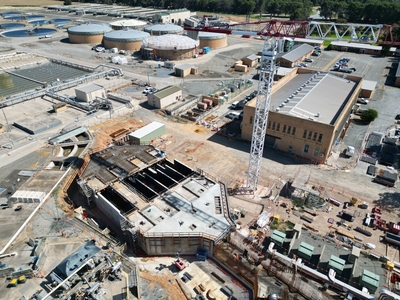This post was originally published on Sustainability Matters

SA Water has just completed the single largest concrete pour at South Australia’s Bolivar Wastewater Treatment Plant — part of a $64 million upgrade that will create a new inlet structure at the facility.
More than 310 cubic metres of concrete was poured into the steel-lined base to create the inlet’s foundation, involving the coordination of around 50 mixing trucks across the complex 15-hour pour.
Bolivar’s new inlet is being built to increase the plant’s capacity to receive and process higher projected flow rates of sewage as Adelaide’s population grows.
SA Water’s Senior Manager of Capital Delivery, Peter Seltsikas, said along with the slab pour, the project has achieved a number of other milestones, including delivery of new screens that will be retrofitted on the inlet and act as the plant’s first line of defence, capturing and removing inorganic material.
“We’ve also recently started replacing three of our existing inlet pipes — which transfer raw sewage from across metropolitan Adelaide to the plant — while they remain temporarily connected to the existing inlet structure,” Seltsikas said.
Bolivar’s capacity to receive sewage from the network will more than double to about 630 million litres per day once the new inlet is operational.
A 20-tonne tower crane was deployed next to the inlet’s concrete slab to help crews lift equipment and pipes into place, along with large panels to facilitate concrete form work.
“Once the new inlet is complete, we’ll change the connections over and construct an additional three inlet pipes to accommodate increased flows that will come into the plant as the local population grows,” Seltsikas said.
“Despite ticking off the project’s single largest concrete pour, we anticipate we’ll need a further 1990 cubic metres, with our team now working on forming the concrete roof structure, overflow channels and walls.”
Seltsikas said SA Water hoped to begin installing the inlet’s mechanical equipment in the next few months. This process will involve eight customised screens, major support steel structure and ancillary items such as penstocks and stoplogs that control and isolate the flow of sewage.
To accommodate future projected flows, Bolivar’s capacity to receive sewage from the network will more than double to around 630 million litres per day once the new inlet is operational.
Top image caption: More than 310 cubic metres of concrete was poured into the steel-lined base to create the inlet’s foundation across the 15-hour operation.





0 Comments